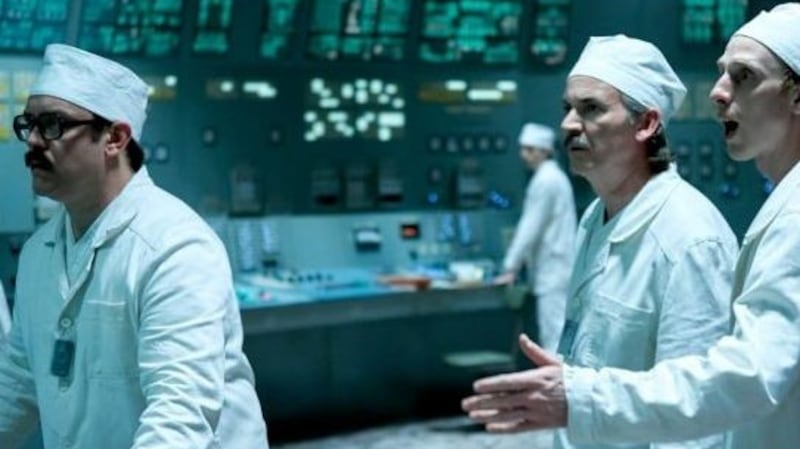One of the most sinister sights in Chernobyl (Sky Atlantic, Tuesday, 9pm), a new five-part miniseries about the 1986 nuclear disaster, is unsettlingly lovely to look at.
It is the middle of a spring night, in Soviet Ukraine, and a fantastic column of light pierces the dark sky like a glowing spire. Nobody has seen anything like it before, for nothing like this has ever happened on earth. People gather outside to watch, some warily, most entranced, as dust gathers in their hair. "Well," says one woman, burying her misgivings, "it is beautiful."
The gathering horror of Craig Mazin's drama for Sky Atlantic and HBO is not just that the people of Pripyat, the town closest to the explosion, have no idea what they're looking at, but that the chiefs of the nuclear power plant, and their superiors, insist it isn't happening at all. Annoyed but calm, the plant's deputy chief Anatoly Dyatlov (Paul Ritter) orders that water be used to quench the reactor core. The problem, as his subordinates try to explain, is that there is no reactor core. It has exploded.
Vomiting and falling
As twisted metal and shattered concrete spill outside the plant, skin begins to prickle and burn inside. Nuclear engineers start vomiting and collapsing. The unimaginable has happened. In the USSR, though, the unimaginable is also deniable.
“Not great, not terrible,” grumbles Dyatlov, at an early radiation reading of 3.6 roentgen, concerned more by what he will tell a communist party committee. (We later learn the real level is 15,000 roentgen, or twice the radiation of the Hiroshima atomic bomb, released every hour - the instruments at Chernobyl could only measure as high as 3.6.)
This fallout is capable of contaminating not just Ukraine, Belarus and Russia, but the entire continent. To combat it, of course, the Soviets used the most powerful tools available, namely ideology.

“We seal off the city, let no one leave, and cut the phone lines to prevent the spread of misinformation,” affirms one party panjandrum. “This is our moment to shine.” On the last point, he is almost right: the radioactive air is glowing.
Under Johan Renck’s direction, these scenes are as grim as the architecture, brutal and unforgiving.
Mazin is fidgety with his storytelling. We open, a little needlessly, with the suicide of his protagonist, the frowning atomic energy professor Valerie Legasov (the suitably lugubrious Jared Harris), then hop back two years ("and one minute") for an unstintingly detailed chronology of the accident. These details of the disaster are too important to skimp – more so, because they were so long suppressed – but they arrive too early to be explained.
Surprising sympathy
That's why viewers may feel a surprising level of sympathy for Stellan Sarskard's nicely played party apparatchik Boris Shcherbina, arriving in the second episode, who asks the important questions: "How does a nuclear reactor work?"
Legasov himself, we understand, is wary of stories: “If we hear enough lies we may not even recognise the truth at all,” he announces early. That resonates today, in an era irradiated with charges of “fake news”. That may explain Mazin’s careful, conventional narrative, seeking to unravel years of state dissembling and cover up. Chernobyl was undermined by two damaged systems, the show suggests: its reactor processes and Sovietism itself. “I prefer my opinion to yours,” one official tells Emily Watson’s alarmed nuclear scientist, Ulyana Khomyuk, in a later episode.)
But for all the wheezing party members, there were many brave souls who rushed to the disaster zone to assist with immense sacrifice. That Mikhail Gorbachev, then general secretary of the CPSU, plays a supporting role to them is significant: you can draw a line from the sclerotic official response to Chernobyl and the dawn of glasnost.
As appalling – and continuing – as the fallout from Chernobyl has been, it was eventually contained. The fallout from its political handling never could be.



















